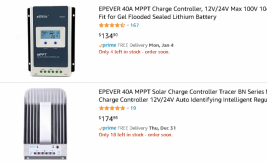My 40A EPever, I understand (had to learn so bias) how to configure it so that I would stay inside my own battery charging limits. It allows good customization on charging values. I would look for that feature, at least for me. Also, the EPever 40a needs #6 wire and it says it will take that wire size, but I don't think it would take any larger size. So I would also look at the wire terminals, specifically the one to the battery, as this one will have more current than from the panels. I can't find a Youtube review on it.
Better than Amazon, not sure of shipping.
Comments about
programming SSC, in general. Note Will doesn't recommend connecting EPEver to PC but if you know how to figure stuff like that out, it is not super hard. I agree it is clunky if you don't use it often enough to remember the steps.
No information on how you connect to a PC with the RS-485 port.
Yeah, as far as programmability for charging limits, I understand all of that and will be certain the Reliable is at least as programmable as the Epever.
And also on cable size, I’d already checked that the Reliable accepts at least the same cable size as the Epever.
What I’m struggling to understand now is ‘MPPT Voltage Range’ and what that means in the real world.
For 24V charging, the Epever has an MPPT range of Vbattery + 2V. I believe Vbattery is a reference to the actual voltage of the battery meaning 28.4V if I want to get my 8S LiFePO4 charger all the way up to 3.55V / cell.
So if I want my LiFePO charging to 28.4V, minimum Vmppt will be 30.4v and I think that means I need panels with Voc of >30.4V or the Epever will just clamp voltage at the minimum of 30.4V where current output will be 0A.
If this understanding is correct, the Reliable inverter is slightly worse since it has a minimum MPPT voltage of 34V, meaning it will only function with panels whose Voc exceeds 34V.
I’ve never used a charge controller before and realize I’m not fully understanding how the MPPT function works. Is it as follows:
-Vminmppt clamped on output until current starts being output by PV array at that voltage.
-Once current output is recognized, Vmppt increased on increments until power (current x Vmppt) declines.
-Once battery is charged and current from PV array needs to be reduced, Vmppt increased until power matches target and once power target reaches 0W, Vmppt increased to Voc or higher.
Would appreciate a confirmation of this understanding is correct. If so, it means that the Epever will work with a wider range of panels when charging 24V batteries (but in any case, either of these chargers will function much better with 2S PV strings...).





